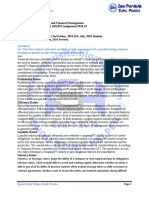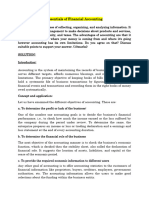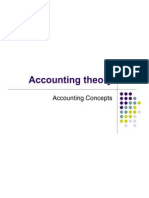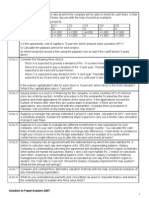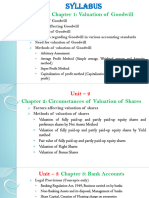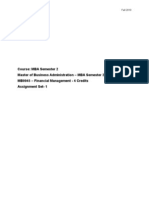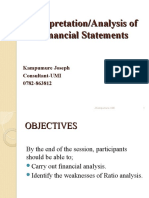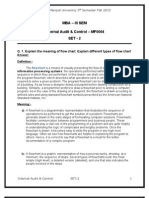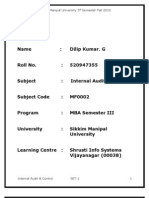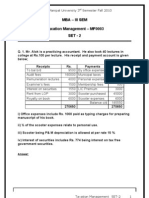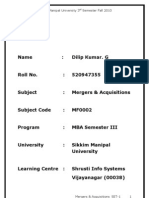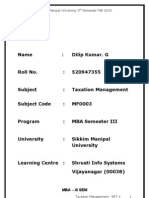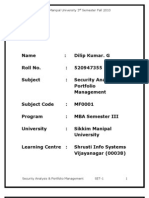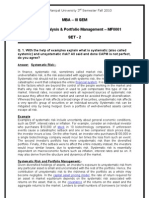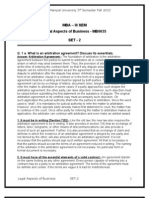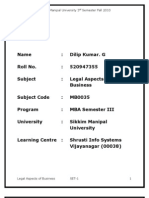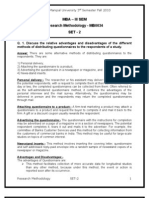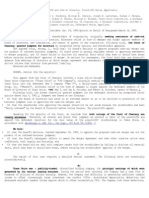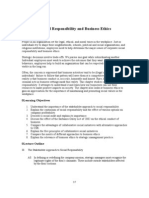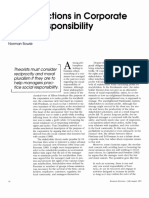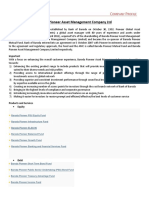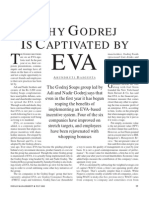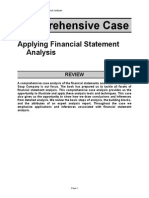Mba - Iii Sem Mergers & Acquisitions - MF0002 Set - 2
Mba - Iii Sem Mergers & Acquisitions - MF0002 Set - 2
Uploaded by
Dilipk86Copyright:
Available Formats
Mba - Iii Sem Mergers & Acquisitions - MF0002 Set - 2
Mba - Iii Sem Mergers & Acquisitions - MF0002 Set - 2
Uploaded by
Dilipk86Original Title
Copyright
Available Formats
Share this document
Did you find this document useful?
Is this content inappropriate?
Copyright:
Available Formats
Mba - Iii Sem Mergers & Acquisitions - MF0002 Set - 2
Mba - Iii Sem Mergers & Acquisitions - MF0002 Set - 2
Uploaded by
Dilipk86Copyright:
Available Formats
Sikkim Manipal University 3rd Semester Fall 2010
MBA – III SEM
Mergers & Acquisitions – MF0002
SET - 2
Q. 1. Explain the accounting treatment of share premium, goodwill and
other profits.
Answer:
Accounting Treatment of shares on premium:
Sometime a company can decide to issue of shares on premium or on discount. In
both situations we must know the basic concept before doing any accounting
treatment.
Issue of shares on premium:
Issue of shares on premium means that if company wants to get more money of each
share. Then the company can demand premium with the face value or nominal value
of shares. This is called issue of shares on premium. Suppose if the face value of
shares is RS.100 Company can issue of his 10000 @ Rs. 105 it means company is
also demanding Rs. 5 per share as premium. According to new amendments in
Company law 1956, Company must open security premium account, if co. issue
shares on premium. All money which got with name of premium will transfer to
security premium account . The following entry will passed in the books of company
1. For due of Share Allotment money
Shares Allotment Account Debit xxxx (with the total amount)
To Shares Capital Account Credit xxxx (with the face value of shares)
To Security Premium Account Credit xxxx (with the amount of premium)
2. For Allotment money Received
Bank Account Debit xxxx (face value + Premium)
To Share Allotment Account xxxx
If company has demanded the premium with his call money from share holders, then
on the place share allotment account we must write share call account, all other
journal entry will be same.
According to Section 78, we will use this fund according to guidelines of law.
Meaning of Issue of shares at discount:-
It means that company demands less amount than face value of shares .This
less amount is called discount on issue of shares.
Mergers & Acquisitions SET-2 1
Sikkim Manipal University 3rd Semester Fall 2010
Journal entry of discount on issue of shares
When we receive allotment by giving discount on issue of share
1 Amount due of allotment
Share Allotment Account Debit xxxx (face value of allotment – discount)
Discount on issue of share account Debit xxxx (amount of discount)
To Share capital account xxxx
2. When allotment money actually received
Bank account debit xxxx (face value of allotment –discount)
To share allotment account xxxx
Accounting treatment of goodwill:
The issue of goodwill has been debated in many countries throughout the world.
Despite numerous efforts and the existence of accounting standards and exposure
drafts issued by various professional bodies internationally, there is yet to be a
universally accepted accounting treatment for goodwill. The opinion on this subject
differs and changes frequently. The dichotomy of having to preserve prescribed
recognition criteria on the one hand and the need to report useful information on the
other has led to the many controversial issues debated on the subject of goodwill.
This study centres around the international accounting treatment of goodwill in the
past, present and future. This study reviewed some of the issues that surrounded the
accounting for goodwill where it was found that goodwill accounting had faced many
problems. Besides problems, this project also looks into the prospect of the
accounting for goodwill in the cyberspace era and emergence of the knowledge-
based economy. This study confirms that controversy remains internationally with no
solution in sight in the foreseeable future internationally.
The Financial Accounting Standards Board (FASB) Statement #142, Goodwill and
Other Intangible Assets, addresses how intangible assets that are acquired
individually or with a group of other assets should be accounted for in the acquiring
company's financial statements subsequent to their initial recognition. Under FAS
142, goodwill and certain intangible assets will no longer be amortized over a
specified, hypothetical, useful life. In addition, goodwill and other intangible assets
will no longer be amortized using straight line amortization meaning the amount of
amortization will probably not be the same each year.
Fundamentally, FAS 142 rejects the idea that all intangible assets are necessarily
"wasting" assets. Under FAS 142, goodwill and intangible assets that have indefinite
useful lives will not be amortized over a theoretical fixed lifetime. Instead, they will be
tested annually for impairment - with the exception of intangible assets that are
identified as having finite useful lives that will continue to be amortized, but without
the constraint of an arbitrary maximum useful life of forty years. Under FAS 142,
goodwill and other intangibles will still be recognized as assets. Impairment testing
will be done using a two-step process. The first step involves reviewing the assets in
question for impairment.
Mergers & Acquisitions SET-2 2
Sikkim Manipal University 3rd Semester Fall 2010
Accounting treatment of goodwill:
Capitalisation and amortisation method
Companies valuing goodwill, follow the residuum approach to capitalise their assets.
The net affect of this approach is that, the goodwill account also includes all other
assets that are identifiable by the company. Thereby the goodwill account reflects an
incorrect picture of intangible assets. One method of correcting this error is to use the
‘Hidden Assets approach’. Under this method, the excess purchase price that
companies pay over the fair market value of assets is for assets that are not shown
or hidden from the balance sheet.
These hidden assets can be both tangible and as intangible in nature. They must be
identified, recorded in the balance sheet and then amortised over their appropriate
economic life. Then, the goodwill account reflects the true picture of only intangible
assets.
Amortisation of recorded goodwill enables the company to match the cost of
intangible assets with benefits from their use. The point of focus in this case is the
period over which amortisation must take place. If the life of the asset is not
determinable, as in the case of goodwill, amortisation of its value is done over a
period of about 40 years. This will cause a minimal impact of writing off of goodwill on
the annual net income.
Showing the accounting treatment by means of an example of ABC Ltd.
Assets Rs.20000
Liabilities Rs.5000
Owner’s equity Rs.15000
ABC owns land the historical cost of which is Rs.6000, but currently worth Rs.13000.
Market value of the land is Rs.7000 more than its book value.
PQR ltd. purchases the outstanding stock of ABC for Rs.32000, price based on the
market position and earnings performance of the company over the past few years.
Market value of acquired assets is calculated as follows:
Assets: Rs.20000 + Rs.7000 excess land value = Rs.27000
Market value of acquired liabilities Rs.5000
Market value of net assets Rs.22000
The firm sold all its assets and paid off its liabilities. Purchase price is
Rs.32000.hence PQR ltd. will record Rs.10000 as goodwill on the purchase. It must
be noted that Rs.7000 from the excess Rs.10000 is attributable to the excess of
market value of land over the book value.
Hence Rs.32000 purchase price can be divided into three amounts for accounting
purposes:
Acquired company’s Rs.15000
owner’s equity
Excess of market value Rs.7000
of land
Goodwill Rs.10000
Total purchase price Rs.32000
Mergers & Acquisitions SET-2 3
Sikkim Manipal University 3rd Semester Fall 2010
PQR ltd. capitalises goodwill and assumes a 10-year period as the economic life of
goodwill. The annual accounting entry for goodwill would be:
Journal entry:
Amortisation of Goodwill -------------Debit 1000
To Goodwill 1000
Capitalisation and no amortisation
This method is most beneficial for a company. The company using this method gets
to record the asset in the balance sheet instead of deducting it from owner’s equity.
As there is no amortisation, there is no yearly reduction of net income. The reason for
such a treatment is that goodwill consisting of managerial ability, reputation and
experience generally increases in value over time. This method views goodwill as an
investment and hence it should stay on the balance sheet amortised.
Write off method
Under this method, goodwill is immediately written off against the equity
stockholder’s account, generally from retained earnings.
Accounting Treatment for other Profit;
1. you can pay arbitrage commission. For that you have to make agreement with
dealer to pay commission of sharing basis and TDS provisions for commission would
be applicable.
2. You can employ dealers and can pay salary to them. If you opt this treatment then
you have to pay them a fix basic salary and variable performance incentive to them.
In this case, TDS provisions for salary would be applicable.
3. If you are a main broker, you can share your profits. For that, you have to make
agreement for sharing of profits with dealers. In the agreement, you should made
provisions such as margin would be payable upfront by the dealer and if he fails to do
so, you would charge interest on your funding and you and dealer would share profit
with a fix ratio, etc. In this case, you are not required to deduct TDS.
Q2. Describe the techniques of raid and defenses against takeover bid.
Answer: Takeover implies acquisition of controlling interest in a company by another
company by taking over of the shares listed on any stock exchange. It does not lead
to the dissolution of the company whose shares are being or have been acquired. It
simply means a change of controlling interest in a company through the acquisition of
its shares by another group. The acquisition transactions in such shares are subject
to the conditions of listing agreement. When a profit earning company takes over a
financially sick company to bail it out, it is known as ‘bail out takeover’. Such
takeovers are in pursuance of a scheme of rehabilitation approved by public financial
institutions. Corporate takeovers in India are governed by the listing agreement with
Mergers & Acquisitions SET-2 4
Sikkim Manipal University 3rd Semester Fall 2010
stock exchanges and the SEBI Substantial Acquisition of Shares and Takeover
(SEBI Code) Code. The raid, bids and defences are the outcome of takeover.
Corporates can stall such takeover through strategic defensive steps.
Mergers and takeovers are motivated and negotiated under the dominance of
hostility and friendliness pressure and influences and are accordingly classified as
friendly mergers and hostile mergers. The raids, bids and defences are the outcome
of human moods. Corporate wars and offensive postures can be avoided and can be
stalled through defensive steps.
Raid Techniques
Techniques used in raids are such as Techniques of raid takeover bid and tender
offer. The procedure for organizing takeovers includes collection of relevant
information and its analysis, examine shareholders' profile, investigation of title and
searches into indebtedness, examining of articles of association etc,. Defence
against takeover bid may be in the form of advance preventive measures for defence
such as - joint holdings or joint voting agreement, interlocking shareholdings or cross
shareholdings, issue of block of shares to friends and associates, defensive merger
apart from other things. Tactical defence' strategies include friendly purchase of
shares, emotional attachment, loyalty and patriotism, recourse to legal action,
operation ‘White Knights', "Golden Parachutes" etc,.
Four basic tactics or schemes can be carved out when we study the practice of
corporate raiding which are bankruptcy, corporate, litigation, and land schemes to be
the most widespread apart from the other supplementary tactics such as the creation
and presentation of false evidence in civil litigation. At least three causes can be
identified, first is the general uncertainty of property rights resulting from the
privatization of state assets, second cause is poor corporate governance and final
cause of raiding is the fact that the legal system is simply not yet equipped to deal
with this novel form of crime. The court structure, the inadequacy of criminal law, the
flaws in criminal investigation, the problems of good faith purchaser and the
verification of corporate documents are also among the loopholes that can be
identified. In order to address this problem, a new bankruptcy law must be imposed
with more stringent screening and ethical requirements for trustees, expanding the
time for judges to consider and take decisions, and also expand debtors' rights to
contest creditors' petitions.
The corrupt acquisition of control over the target company usually by falsifying
internal corporate documents and/or corruptly obtaining control over a significant
portion of the voting stock or the board of directors of the target company is common
in nature. The raider may create a false power of attorney or other document
authorizing him or a co-conspirator to enter into transactions on behalf of the target
company and then transfer the target's assets to himself or affiliated companies or
the raider bribes officials at state registration agencies to alter the target company's
registration documents to give him and/or his confederates faux control over the
target company. He then uses this control to drain off the target's assets.
Another important tactic that may be used by raider is the creation and presentation
of false evidence in civil litigation. For example, in answering claims by victims,
Mergers & Acquisitions SET-2 5
Sikkim Manipal University 3rd Semester Fall 2010
raiders typically offer false evidence, such as fabricated contracts and corporate
resolutions, to "prove" the alleged legitimacy of their acquisitions. There are certain
measures that businesses can take to protect themselves. These measures include
retaining qualified legal counsel to draft and review all incorporation documents and
contracts, retaining corporate investigation firms to investigate partners and major
customers, and, above always complying with all relevant laws and regulations.
The term ‘takeover' is nowhere defined in the Companies Act 1956 (Act) or in
Securities and Exchange Board of India Act, 1992 (SEBI Act), or in SEBI (Substantial
Acquisition of Shares and Takeovers) Regulations, 1997 (Takeover Code). In the
absence of a legal definition, the term takeover has to be understood from its
commercial usage. In commercial parlance, the term takeover denotes the act of a
person or group of persons (acquirer) acquiring shares or acquiring voting rights or
both of a company (target company), from its shareholders, either through private
negotiations with majority shareholders, or by a public offer in the open market with
an intention to gain control over its management. A takeover is considered ‘hostile'
when the management of the target company resists the attempted takeover.
The basic principle is that when acquisition becomes a takeover, the Takeover Code
becomes applicable besides other provisions of the Act. In other words, in case of a
takeover, compliance of both the Takeover Code as well as that of the Act is
necessary, while in case of acquisition, compliance of only the Act is required.
Further, if an acquisition results in a ‘combination', then the provisions of the
Competition Act 2002 also become applicable, and the approval of the Competition
Commission of India is required. If the acquisition results in either inflow or outflow of
funds, to or from India, then the provisions of the Foreign Exchange Management Act
1999 would become applicable and in such a case, the permission from either the
Reserve Bank of India or the Central Government may be required.
The objective behind the Takeover Code is to bring transparency in takeover and
acquisition transactions in public listed companies and to ensure that if minority
shareholders are not given a raw deal through price fixation. The Takeover Code lays
down the mandatory and compulsory disclosure of an acquisition if the acquirer
intends to do. The procedure in case an investor wants to takeover has been clearly
laid down in the Companies Act, 1956, the Takeover Code etc,. These regulatory
mechanisms also lays down the offences, penalties in case of any violation,
obligations and restrictions upon the merchant bankers, acquirers, the company itself
etc,. Acquisition for the purpose of combination is not only the acquisition of shares
or voting rights or control of management, but also acquisition of or control of assets
of the target company. Thus, for the purposes of Competition Act, 2002, acquisition
of shares, voting rights, assets and control of management have to be considered. In
Any combination that would result in appreciable adverse effect on competition,
within the relevant market in India, would be declared null and void and such an
effect is to be enquired by the CCI for which the powers and the procedure is laid
down under the Competition Act, 2002.
However, the era of the corporate raider appears to be largely over. In the later
1980s the famous raiders suffered from a number of bad purchases that lost money
(for their backers, primarily) and the credit lines dried up. In addition, corporations
became more adept at fighting hostile takeovers through mechanisms such as the
Mergers & Acquisitions SET-2 6
Sikkim Manipal University 3rd Semester Fall 2010
poison pill. Finally the overall price of the stock market increased, which reduced the
number of situations in which a company's share price was low with respect to the
assets that it controlled...
Defenses against Takeover Bid:
The following Defensive method measures can be adopted to face takeover bids:
Advance preventive measures for Defenses:- The target company should take
precautions when it feels that takeover bid is imminent through market reports or
available information. Some of the advance measures are discussed below:
Joint Holdings or Joint Voting Agreement:- Two or more major
shareholders may enter into agreement for block voting or block sale of shares
– rather than separate voting or sale of shares. This agreement is entered
into, in collaboration with or without cooperation of target company’s directors
who wish to exercise effective control of the company.
Inter locking Share Holdings or Cross Share Holdings:- Two or more
group companies acquire share of each in large quantity or one company may
distribute share to the shareholders of its group company to avoid threats of
takeover bids. If the interlocking of share holdings is accompanied by joint
voting agreement, then the joint system of advance defense could be termed
as “Pyramiding”, the safest device of defense.
Issue of Block Shares to Friends and Associates:- The director’s issue
block shares to their friends and associates to continue maintaining their
controlling interest and as a safeguard to the threats of dislodging their control
position. This may also be done by issue of right shares.
Defensive Merger:- The directors of a threatened company may acquire
another company for shares as a defensive measure to forestall two
unwelcome takeover bids. For this purpose they put long block shares of their
own company in the hands of shareholders of friendly to make their own
company least attractive for takeover bid.
Share with non-voting rights like preference shares:- Non-voting shares
are a convenient method of providing for any desired adjustment of control on
a merger of two companies.
Mergers & Acquisitions SET-2 7
Sikkim Manipal University 3rd Semester Fall 2010
Convertible Securities:- It is necessary that the company’s capital structure
should contain loan capital by way of debentures to make the company less
attractive to corporate raiders.
Dissemination to shareholders of favourable financial information:- The
dissemination of information about the company’s favourable features of
operations and profitability go a long way in bringing the market price of share
nearer to its true assets’ value. This type of behaviour on the part of the
directors of the company elicit confidence of shareholders in their
management and control which will in many ways help preventing any
takeover bid to be in or to succeed.
Making the possession of two company’s asset less attractive:- This is
possibly done by putting the assets outside the control of the shareholders by
entering into various types of financial arrangements like sale and lease back,
mortgage of assets to FIs for long term loans etc.
Long Term services Assessments:- Directors having specialized skills in
any specific technical field may enter into contract with the company with the
specific approval of shareholders or the Companies Act 1956. The prospective
bidder would not be attracted due to:
• Fear of non-co-operation by such director
• High compensation for terminating the agreement.
In view of these circumstances, the takeover game becomes unattractive to
the bidders.
Other preventive measures:
1. Maintaining a fraction of share capital uncalled, which can be called up during any
emergency like takeover bid or liquidation threat. Such strategy is known as “Rainy
day call”.
2. Companies may form group or cartel to fight against any future bid of takeover by
way of pooling funds to use it to counter the takeover bids.
Mergers & Acquisitions SET-2 8
Sikkim Manipal University 3rd Semester Fall 2010
Defense in face of takeover bid (Strategies):
A company is supposed to take defensive steps when it comes to know that some
corporate raider has been making efforts for takeover. For defense against takeover
bid, two types of strategies could be as below:
1. Commercial Strategies
1. Dissemination of favourable information among shareholders.
2. Step up dividend and update share price record (i.e. pushing up share price)
3. To revalue the fixed assets periodically and incorporate them in the balance sheet
4. Reorganization of Capital structure
5. Research based arguments should be prepared to show and convince the
shareholders that the offer is incapable of managing the business.
6. Trace out the various discouraging commercial features of the functioning of the
acquiring company (e.g. Pending cases in labour/consumer/tax tribunal)
2. Tactical / Defense Strategies
1. The directors of the company may persuade their friends and relatives to purchase
the shares of the offeree company
2. The board may make attempt to win over the shareholders through raising their
emotional attachment, loyalty and patriotism etc.
3. Recourse to legal actions:-
In order to defuse situation of hostile takeover attempts, companies have been given
power to refuse to register the transfer of shares under relevant sections of
Companies Act 1956. If this is done, a company must inform the transferee and the
transferor within 60 days. It is the responsibility of the directors to accept a takeover
bid.
A refusal to register is permitted if:
- A legal requirement relating to the transfer of shares is not complied with
- The transfer is in contravention of the law
- The transfer is prohibited by a court order
- The transfer is not in the interest of the company and public.
4. Operation “White Knights”:- The white knight defense involves choosing another
company with which the target prefers to be combined. A target company is said to
Mergers & Acquisitions SET-2 9
Sikkim Manipal University 3rd Semester Fall 2010
use a “white knight” when its management offers to be acquired by a friendly
company to escape from a hostile takeover. An alternative company might be
preferred by the target because it sees greater compatibility, or the new bidder might
promise not to break up the target or engage in massive employees’ dismissal. The
possible motive for the management of the target company to do so is not to lose the
management of the company. White knight offers a higher bid to the target company
than the present predator to avert the takeover bid by hostile suitor. With the higher
bid offered by the “white knight” the predator might not remain interested in
acquisition and hence the target company is protected from losing to corporate raid.
5. White Square:- The white square is a modified form of a white knight. The
difference being that the white square does not acquire control of the target. In a
white square transaction, the target sells a block of its stock to a third party it
considers to be friendly. The white square sometimes is required to vote its shares
with the target management. These transactions often are accompanied by a stand-
still agreement that limits the amount of additional target stock the white square can
purchase for a specified period of time and restricts the sale of its target stock,
usually giving the right of first refusal to the target. In return, the white square often
receives a seat on the target board, generous dividends, and/or a discount on the
target shares. Preferred stock enables the board to tailor the characteristics of that
stock to fit the transaction and so usually is used in white square transaction.
6. Disposing of “Crown Jewel”:- When a target company uses the tactics of
divestiture, it is said to sell the “Crown Jewel”. The precious assets in the company
are called “crown jewel” to depict the greed of the acquirer under the takeover bid.
These precious assets attract the rider to bid for the company’s control. The
company as a defense strategy, in its own interest, sells these valuable assets at its
own initiative leaving the rest of the company intact. Instead of selling these valuable
assets, the company may also lease them or mortgage them to creditors so that the
attraction of free assets to the predator is over. As per SEBI takeover regulation, the
above defense can be used only before the predator makes public announcement of
its intention to take over the target company.
7. ‘Pac-Man’ strategy:- It is making counter bid for the bidder. The Pac-Man defense
is essence involves the target counter offering for the bidder. Under this strategy the
target company attempts to take over the hostile raider. This happens when the
target company is quite larger than predator. This severe defense is rarely used and
in fact usually is designed not to be used. If the Pac Man defense is used, it is
extremely costly and could have devastating financial effects for both firms involved.
There is a risk that under state law, should both firms buy substantial stakes in each
other, each would be ruled as subsidiaries of the other and be unable to vote its
shares against the corporate parent. The severity of the defense may lead the bidder
to disbelieve that the target actually will employ the defense.
8. “Golden Parachutes”:- Golden parachutes are separation provisions of an
employment contract that compensate managers for the loss of their jobs under a
change-of- control clause. The provision usually calls for a lump-sum payment or
payment over a specified period at full or partial rates of normal compensation. When
a company offers hefty compensations to its managers if they get ousted due to
takeover, the company is said to offer golden parachutes. This reduces their
Mergers & Acquisitions SET-2 10
Sikkim Manipal University 3rd Semester Fall 2010
resistance to takeover. This envisages a termination packages for senior executives
and used as a protection to the directors of the company against the takeover bid.
9. “Shark Repellent” character:- The companies change and amend their bylaws
and regulations to be less attractive for the corporate raider company. Such features
in the bylaws are called “Shark Repellent” character. Companies adopt this tactic as
precautionary measure against prospective bids. Eg: Share holder’s approvals for
approving combination proposal are fixed at minimum by 80-95% of the shareholders
meeting.
10. Swallowing “Poison Pills” strategy:- Poison pills represent the creation of
securities carrying special rights exercisable by a triggering event. The triggering
event could be the accumulation of a specified percentage of target shares or the
announcement of a tender offer. The special rights take many forms but they all
make it costlier to acquire control of the target firm. As a tactical strategy, the target
company might issue convertible securities, which are converted into equity to deter
the efforts of the offer, or because such conversion dilutes the bidders shares and
discourages acquisition. Another example, Target Company might rise borrowing
distorting normal Debt to Equity ratio. Poison pills can be adopted by the board of
directors without shareholder approval. Although not required, directors often will
submit poison pill adoptions to shareholders for ratification.
11. Green Mail:- It refers to an incentive offered by the management of the target
company to the potential bidder for not pursuing the takeover. The management of
the target company may offer the acquirer for its shares a price higher than the
market price. A large block of shares is held by an unfriendly company which forces
the target company to repurchase the stock at a substantial premium to prevent the
takeover. The purpose of the premium buyback presumably is to end a hostile
takeover threat by the large block holder or green mailer. This is an expensive
defense mechanism. The large block investors involved in greenmail help bring about
management changes either changes in corporate personnel, or changes in
corporate policy, or have superior skills at evaluation potential takeover targets.
12. Poison Put:- A covenant allowing the bondholder to demand repayment in the
event of a hostile takeover. This poison put feature seeks to protect against risk of
takeover-related deterioration of target bonds, at the same time placing a potentially
large cash demand on the new owner, thus raising the cost of an acquisition. Merger
and acquisition activity in general has had negative impacts on bondholders’ wealth.
This was particularly true when leverage increases where substantial.
13. “Grey Knight”:- A friendly party of the target company who seeks to takeover
the predator. The target company may adopt a combination of various strategies for
successfully averting the acquisition bid.
All the above strategies are experience based and have been successfully used in
developed nations and some of them have been tested by Indian companies also.
Financial Defensive Measures
Mergers & Acquisitions SET-2 11
Sikkim Manipal University 3rd Semester Fall 2010
The firm could become a takeover target of another firm seeking to benefit
from an association with highly efficient firm in terms of:
a. High sales growth
b. High profit margin
c. Low stock price
d. Highly liquid balance sheet
A combination of these factors can simultaneously make a firm an attractive
investment opportunity and facilitate its financing. A firm fitting the afore-
mentioned description would do well to take at least some of the following
steps as defensive measure against takeover:
i. Increase debt with borrowed funds used to repurchase equity.
ii. Increase dividends on remaining shares.
Structure loan covenants to force acceleration of repayment in the event of
takeover.
Liquidate the securities portfolio and draw down excess cash.
Invest continuing cash flows from operations in profitable projects.
Use some of the excess liquidity to acquire other firms.
Divest subsidiaries
Mergers & Acquisitions SET-2 12
Sikkim Manipal University 3rd Semester Fall 2010
Realize the true value of undervalued assets by selling them of or
restructuring.
Q3. Write short notes on:
a. Golden Parachutes
b. Shark Repellent
c. Green Mail
d. Poison Put
Answer:
a. Golden Parachutes:-
A golden parachute is an agreement between a company and an
employee (usually upper executive) specifying that the employee will receive
certain significant benefits if employment is terminated. Sometimes, certain
conditions, typically a change in company ownership, must be met, but often the
cause of termination is unspecified. These benefits may include severance pay,
cash bonuses, stock options, or other benefits. They are designed to reduce
perverse incentives—paradoxically (and ironically) they may create them.
Proponents of golden parachutes argue that they provide three main benefits:
1. Golden parachutes make it easier to hire and retain executives, especially in
industries more prone to mergers.
2. They help an executive to remain objective about the company during the
takeover process.
3. They dissuade takeover attempts by increasing the cost of a takeover, often
part of a Poison Pill strategy, although tin parachutes (giving every employee
takeover benefits and/or job protection) are generally far more effective in this
regard.
Critics have responded to the above by pointing out that:
1. Dismissal is a risk in any occupation, and executives are already well
compensated.
2. Executives already have a fiduciary responsibility to the company, and should
not need additional incentives to stay objective.
3. Golden parachute costs are a very small percentage of a takeover's costs and
do not affect the outcome.
The use of golden parachutes have caused some investors [who?]
[citation needed] concern since they don't specify that the executive has to
perform successfully to any degree. However, benchmarks have never been an
aspect of golden parachutes and their absence only became an issue of public
Mergers & Acquisitions SET-2 13
Sikkim Manipal University 3rd Semester Fall 2010
concern following the stock market declines of 2008 and 2009 and the negative
populist sentiment that ensued afterwards.
The first known use of the term "golden parachute" dates back to when
creditors sought to oust Howard Hughes from control of TWA airlines. The
creditors provided Charles C. Tillinghast Jr. an employment contract—dubbed a
golden parachute in likely[original research?] reference to the protection a
parachute offered—with protection against the almost definite[according to
whom?] job loss Tillinghast would have faced if famed aviator Howard Hughes
had successfully maintained control of TWA.
The use of the term "golden parachute" has significantly increased in
2008 because of the global economic recession, especially being used by news
media and in the 2008 Presidential Debates.
The use of golden parachutes expanded greatly in the early 1980s in
response to the large increase in the number of takeovers and mergers.
According to a 2006 study by the Hay Group human resource
management firm, the French executives' golden parachutes are the highest in
Europe, and equivalent to the funds received by 50% of the American
executives. In contrast, the French standard revenues for executives located
themselves in the European average. French executives receive roughly the
double of their salary and bonus in their golden parachute
b. Shark Repellent:-
Any corporate activity that is undertaken to discourage a hostile takeover,
such as a golden parachute, scorched earth policy or poison pill.
The companies amend their Bye-Laws and regulations to be less attractive for
the raider company. Such features are called Shark Repellents. The company
may issue that 80-95% of the shareholders should approve for the takeover and
75% of the Board of Directors consent.
There are instances when a target company, which is being aimed at for a
takeover resists the same. The target firm may do so by adopting different
means. Some of the ways include manipulating shares as well as stocks and
their values. All these attempts of the target firm resisting its acquisition or
takeover are known as shark repellent.
Slang term for any one of a number of measures taken by a company
to fend off an unwanted or hostile takeover attempt. In many cases, a company
will make special amendments to its charter or bylaws that become active only
when a takeover attempt is announced or presented to shareholders with the
goal of making the takeover less attractive or profitable to the acquisitive firm.
Also known as a "porcupine provision". Most companies want to
decide their own fates in the marketplace, so when the sharks attack, shark
repellent can send the predator off to look for a less feisty target.
While the concept is a noble one, many shark repellent measures are
not in the best interests of shareholders, as the actions may damage the
company's financial position and interfere with management's ability to focus on
critical business objectives. Some examples of shark repellents are poison pills,
scorched earth policies, golden parachutes and safe harbour strategies.
Mergers & Acquisitions SET-2 14
Sikkim Manipal University 3rd Semester Fall 2010
c. Green Mail:-
It refers to an incentive offered by the management of the target company to
the potential bidder for not pursuing the takeover. The management of the target
company may offer the acquirer for its shares a price higher than the market price. A
large block of shares is held by an unfriendly company which forces the target
company to repurchase the stock at a substantial premium to prevent the takeover.
The purpose of the premium buyback presumably is to end a hostile takeover threat
by the large block holder or green mailer. This is an expensive defense mechanism.
The large block investors involved in greenmail help bring about management
changes either changes in corporate personnel, or changes in corporate policy, or
have superior skills at evaluation potential takeover targets.
Tactic:-
Corporate raids aim to generate large amounts of money by hostile takeovers of
large, often undervalued or inefficient (i.e. non-profit-maximizing) companies, by
either asset stripping and / or replacing management and employees. However,
once having secured a large share of a target company, instead of completing
the hostile takeover, the green mailer offers to end the threat to the victim
company by selling his share back to it, but at a substantial premium to the fair
market stock price.
From the viewpoint of the target, the ransom payment may be referred to as a
goodbye kiss. The origin of the term as a business metaphor is unclear, although
it will certainly be understood in context as kissing the green mailer and,
certainly, millions of dollars goodbye. A company which agrees to buy back the
bidder's stockholding in the target avoids being taken over. In return, the bidder
agrees to abandon the takeover attempt and may sign a confidential agreement
with the green mailer who will agree not to resume the maneuver for a period of
time.
While benefiting the predator, the company and its shareholders lose money.
Greenmail also perpetuates the company's existing management and
employees, which would have most certainly seen their ranks reduced or
eliminated had the hostile takeover successfully gone through.
Examples:-
Greenmail proved lucrative for investors such as T. Boone Pickens and Sir
James Goldsmith during the 1980s. In the latter example, Goldsmith made $90
million from the Goodyear Tire and Rubber Company in the 1980s in this
manner. Occidental Petroleum paid greenmail to David Murdoch in 1984.
The St. Regis Paper Company provides an example of greenmail.
When an investor group led by Sir James Goldsmith acquired 8.6% stake in St.
Regis and expressed interest in taking over the paper concern, the company
agreed to repurchase the shares at a premium. Goldsmith's group acquired the
shares for an average price of $35.50 per share, a total of $109 million. It sold its
stake at $52 per share, netting a profit of $51 million. Shortly after the payoff in
March 1984, St. Regis became the target of publisher Rupert Murdoch. St Regis
turned to Champion International and agreed to a $1.84 billion takeover.
Murdoch tendered his 5.6% stake in St. Regis to the Champion offer for a profit.
Mergers & Acquisitions SET-2 15
Sikkim Manipal University 3rd Semester Fall 2010
Prevention:-
Changes in the details of corporate ownership structure, in the investment
markets generally, and the legal requirement in some jurisdictions for companies
to impose limits for launching formal bids, or obligations to seek shareholder
approval for the buyback of its own shares, and in Federal tax treatment of
greenmail gains (a 50% excise tax) have all made greenmail far less common
since the early 1990s.
d. Poison Put:-
A covenant allowing the bond holder to demand repayment in the event of a hostile
takeover. This poison put feature seeks to protect against risk of takeover-related
deterioration of target bonds, at the same time placing a potentially large cash
demand on the new owner, thus raising the cost of an acquisition. Merger and
acquisition activity in general has had negative impacts on bondholders’ wealth. This
was particularly true when leverage increases where substantial.
In bond trading, a bond indenture that gives the bondholder the right to demand
redemption before maturity at its high par value in case certain event happen. Such
pre-designated events include restructuring of the bond issuing company, excessive
dividend distribution to its stockholders, a leveraged buyout, or a hostile takeover
attempt. A poison put helps the management of the target company to deter the
takeover attempt by making it very costly for the bidder. In times of low liquidity,
however, this put works against the management as the bond holders can pressure
the company into a reorganization or to increase its borrowing costs.
In stocks trading, the rights assigned to common stockholders that sharply escalates
the price of their stockholding, or allows them to purchase the company's shares at a
very attractive fixed price, in case of a hostile takeover attempt. also called event risk
covenant. A covenant allowing the bond holder to demand repayment in the event of
a hostile takeover.
A bond that allows bondholders to redeem before maturity at a high
price should certain, named events take place. These events commonly include
restructuring, a leveraged buyout, an attempted hostile takeover, or paying dividends
in excess of a certain amount or percentage. Poison-put bonds can act as an anti-
takeover measure; they help management discourage takeovers by raising their
expense. On the other hand, when the company is going through a difficult time,
poison-put bonds can limit management's restructuring options for the same reason.
Mergers & Acquisitions SET-2 16
You might also like
- BBA-101 (Fundamentals of Accounting)Document10 pagesBBA-101 (Fundamentals of Accounting)Muniba BatoolNo ratings yet
- Quality Database PAN INDIADocument15 pagesQuality Database PAN INDIAJoydeep Sengupta100% (1)
- 19668ipcc Acc Vol1 Chapter-3Document20 pages19668ipcc Acc Vol1 Chapter-3Vignesh SrinivasanNo ratings yet
- Financial Analysis Accounting AssignmentDocument7 pagesFinancial Analysis Accounting AssignmentNaman KansalNo ratings yet
- BF-2 Assignment 1Document8 pagesBF-2 Assignment 1sabya.rathoreNo ratings yet
- Valuationofgoodwillandsharesl 171209084328Document48 pagesValuationofgoodwillandsharesl 171209084328Shweta ShrivastavaNo ratings yet
- Fa Unit 3Document11 pagesFa Unit 3VTNo ratings yet
- MCS-035 2018-19Document9 pagesMCS-035 2018-19Jatin AgarwalNo ratings yet
- NCERT SolutionsDocument5 pagesNCERT Solutionspalak mahobiyaNo ratings yet
- Redemption of Shares NotesDocument14 pagesRedemption of Shares Notesms.AhmedNo ratings yet
- "Preface" "Hand Book"Document13 pages"Preface" "Hand Book"deepakgrajani_355197No ratings yet
- Revenue RecognitionDocument23 pagesRevenue Recognitiongst.newofficecaNo ratings yet
- Financial Reporting: Othm Level 5 Diploma in Accounting and BusinessDocument33 pagesFinancial Reporting: Othm Level 5 Diploma in Accounting and BusinessDime PierrowNo ratings yet
- Class 11 Accountancy Part 1 Chapter 2Document4 pagesClass 11 Accountancy Part 1 Chapter 2Ioanna Maria MonopoliNo ratings yet
- Essentials of Financial Accounting - 1st SEMDocument10 pagesEssentials of Financial Accounting - 1st SEMParichay Pal100% (1)
- Ias Sem 5Document8 pagesIas Sem 5Pradumn AgarwalNo ratings yet
- DepreciationDocument13 pagesDepreciationAnirban BiswasNo ratings yet
- 14 Misc. Topic (Theory)Document4 pages14 Misc. Topic (Theory)Aakshi SharmaNo ratings yet
- Framework - QB PDFDocument6 pagesFramework - QB PDFHindutav aryaNo ratings yet
- Window DressingDocument5 pagesWindow DressingreshmaNo ratings yet
- The Company Audit - II: © The Institute of Chartered Accountants of IndiaDocument35 pagesThe Company Audit - II: © The Institute of Chartered Accountants of IndiaHarikrishnaNo ratings yet
- FRA Term End Project - Burger KingDocument15 pagesFRA Term End Project - Burger KingRIYANo ratings yet
- Finance DossierDocument108 pagesFinance DossierAbhishek VarshneyNo ratings yet
- Acc 702 Assignment 1Document11 pagesAcc 702 Assignment 1laukkeasNo ratings yet
- Homework Questions For Tutorial in Week 7 With SolutionDocument12 pagesHomework Questions For Tutorial in Week 7 With SolutionrickNo ratings yet
- CFR Notes and Imp QuestionsDocument661 pagesCFR Notes and Imp Questionsbhuvana600048No ratings yet
- 74709bos60485-inter-p1-cp8-u2Document22 pages74709bos60485-inter-p1-cp8-u2kartiksim34088No ratings yet
- Accounting Shenanigans On The Cash Flow Statement IFT NotesDocument8 pagesAccounting Shenanigans On The Cash Flow Statement IFT NoteskautiNo ratings yet
- 2021-2024 Semester-I Division-A Accounting Standard-9 Revenue Recognition Subject:Financial AccountingDocument8 pages2021-2024 Semester-I Division-A Accounting Standard-9 Revenue Recognition Subject:Financial AccountingTushar NarangNo ratings yet
- 9 Framework For Preparation - Presentation of Financial StatementsDocument13 pages9 Framework For Preparation - Presentation of Financial StatementssmartshivenduNo ratings yet
- Accounts & Finance Notes 1Document7 pagesAccounts & Finance Notes 1yeshhudNo ratings yet
- FA-I Sem1 (Gen) 2022Document7 pagesFA-I Sem1 (Gen) 2022shekharendu7No ratings yet
- AccountancyDocument7 pagesAccountancyAditi prakashNo ratings yet
- Accounting TheoryDocument32 pagesAccounting TheoryVicky VijayvargiyaNo ratings yet
- Placement Preparation FinanceDocument73 pagesPlacement Preparation FinanceTopsy KreateNo ratings yet
- AccountingDocument14 pagesAccountingpremiumtutorinfoNo ratings yet
- Accouning StandardsDocument9 pagesAccouning StandardsRajeshwari VishwakarmaNo ratings yet
- Sbaa1301 - Unit 4Document15 pagesSbaa1301 - Unit 4sethupathisuresh1963No ratings yet
- Chapter 3-Valuation of GoodwillDocument12 pagesChapter 3-Valuation of GoodwillnabhayNo ratings yet
- Mll Business Studies Class Xii Kendriya Vidyalaya Sangthan Ro SilcharDocument5 pagesMll Business Studies Class Xii Kendriya Vidyalaya Sangthan Ro SilcharManglam GuptaNo ratings yet
- Interview Related QuestionsDocument8 pagesInterview Related QuestionsAnshita GargNo ratings yet
- How To Read Financial Statements of Indian Listed Companies?Document11 pagesHow To Read Financial Statements of Indian Listed Companies?DrDhananjhay GangineniNo ratings yet
- Acc 702 Assignment 4Document8 pagesAcc 702 Assignment 4laukkeasNo ratings yet
- Solutions Corporate FinanceDocument28 pagesSolutions Corporate FinanceUsman UddinNo ratings yet
- Ncert SolutionsDocument33 pagesNcert SolutionsArif ShaikhNo ratings yet
- NCERT Solutions For Class 11 Accountancy Financial Accounting Part-1 Chapter 2Document7 pagesNCERT Solutions For Class 11 Accountancy Financial Accounting Part-1 Chapter 2Yasir Hameed MayoNo ratings yet
- Chapter 1 Valuation of GoodwillDocument83 pagesChapter 1 Valuation of GoodwillNamasviNo ratings yet
- Amity Business School: MBA Class of 2012, Semester IDocument21 pagesAmity Business School: MBA Class of 2012, Semester IMayank TiwariNo ratings yet
- Unit 2: Overview of Accounting Standards: After Studying This Unit, You Will Be Able ToDocument138 pagesUnit 2: Overview of Accounting Standards: After Studying This Unit, You Will Be Able Totauseefalam917100% (1)
- Quick Revision Acc Xii Ziet CHDDocument41 pagesQuick Revision Acc Xii Ziet CHDanasmansoori545No ratings yet
- Framework For Preparation & Presentation of Financial StatementsDocument9 pagesFramework For Preparation & Presentation of Financial StatementsAyushi AgrawalNo ratings yet
- Framework For Preparation & PresentationDocument8 pagesFramework For Preparation & PresentationvgbhNo ratings yet
- Trading Basics: AccountingDocument10 pagesTrading Basics: AccountingNonameforeverNo ratings yet
- Revised BDM - Sample Q&A SolveDocument13 pagesRevised BDM - Sample Q&A SolveSonam Dema DorjiNo ratings yet
- Profit or Ioss Pre and Post IncorporationDocument22 pagesProfit or Ioss Pre and Post IncorporationRanjana TrivediNo ratings yet
- MB0045 - Mba 2 SemDocument19 pagesMB0045 - Mba 2 SemacorneleoNo ratings yet
- Interpretation of Financial Statements - Use This Copy.Document38 pagesInterpretation of Financial Statements - Use This Copy.muzaire solomon100% (1)
- D Business Combinations - IFRS 3 (Revised)Document10 pagesD Business Combinations - IFRS 3 (Revised)Brook KongNo ratings yet
- Understanding Financial StatementsDocument15 pagesUnderstanding Financial StatementsstratdoughseekerNo ratings yet
- Financial Accounting - Want to Become Financial Accountant in 30 Days?From EverandFinancial Accounting - Want to Become Financial Accountant in 30 Days?Rating: 3.5 out of 5 stars3.5/5 (2)
- Mba - Iii Sem Internal Audit & Control - MF0004 Set - 2Document26 pagesMba - Iii Sem Internal Audit & Control - MF0004 Set - 2Dilipk86No ratings yet
- Name: Dilip Kumar. G Roll No.: 520947355Document10 pagesName: Dilip Kumar. G Roll No.: 520947355Dilipk86No ratings yet
- MF0003 Set-2Document7 pagesMF0003 Set-2Dilipk86No ratings yet
- Name: Dilip Kumar. G: Sikkim Manipal University 3 Semester Fall 2010Document9 pagesName: Dilip Kumar. G: Sikkim Manipal University 3 Semester Fall 2010Dilipk86No ratings yet
- Name: Dilip Kumar. G: Sikkim Manipal University 3 Semester Fall 2010Document11 pagesName: Dilip Kumar. G: Sikkim Manipal University 3 Semester Fall 2010Dilipk86No ratings yet
- Sikkim Manipal University 3 Semester Fall 2010Document14 pagesSikkim Manipal University 3 Semester Fall 2010Dilipk86No ratings yet
- Mba - Iii Sem Security Analysis & Portfolio Management - MF0001 Set - 2Document10 pagesMba - Iii Sem Security Analysis & Portfolio Management - MF0001 Set - 2Dilipk86No ratings yet
- Mba - Iii Sem Legal Aspects of Business - MB0035 Set - 2Document15 pagesMba - Iii Sem Legal Aspects of Business - MB0035 Set - 2Dilipk86No ratings yet
- Sikkim Manipal University 3 Semester Fall 2010Document21 pagesSikkim Manipal University 3 Semester Fall 2010Dilipk86No ratings yet
- Sikkim Manipal University 3 Semester Fall 2010Document22 pagesSikkim Manipal University 3 Semester Fall 2010Dilipk86No ratings yet
- Mba - Iii Sem Research Methodology - MB0034 Set - 2Document24 pagesMba - Iii Sem Research Methodology - MB0034 Set - 2Dilipk86No ratings yet
- Project Equity Research Analysis Between ICICI Bank and HDFC BankDocument3 pagesProject Equity Research Analysis Between ICICI Bank and HDFC BankMalay ShahNo ratings yet
- Smith V Van GorkomDocument21 pagesSmith V Van GorkomjfgoetzNo ratings yet
- Strategic MGMT ch03Document24 pagesStrategic MGMT ch03farazalam08100% (7)
- Berkshire HathawayDocument5 pagesBerkshire Hathawaypatrick olaleNo ratings yet
- The Coffee Can Portfolio PDFDocument5 pagesThe Coffee Can Portfolio PDFVenkata Ramana PothulwarNo ratings yet
- Bowie 1991Document10 pagesBowie 1991JoellePeiXianNo ratings yet
- Jun 2005 - Qns Mod BDocument14 pagesJun 2005 - Qns Mod BHubbak KhanNo ratings yet
- Tanishq PPT On Dividend Contamporary AuditDocument11 pagesTanishq PPT On Dividend Contamporary AuditTaniShq rastogiNo ratings yet
- HSC Commerce March 2018 Board Question Paper SPDocument2 pagesHSC Commerce March 2018 Board Question Paper SPRaj Mishra0% (2)
- G.R. No. 167519. THE WELLEX GROUP, INC., Petitioner, vs. U-LAND AIRLINES, CO., LTD., RespondentDocument77 pagesG.R. No. 167519. THE WELLEX GROUP, INC., Petitioner, vs. U-LAND AIRLINES, CO., LTD., RespondentMa. Christian RamosNo ratings yet
- SIP Plus One Pager InvestorDocument2 pagesSIP Plus One Pager InvestorRohit RaiNo ratings yet
- Dinar Annisa - 142180194 - Tugas 2Document4 pagesDinar Annisa - 142180194 - Tugas 2Salsa BilaNo ratings yet
- Daftar PustakaDocument6 pagesDaftar PustakaamaliatriutamiNo ratings yet
- Baroda Pioneer Asset Management Company LTDDocument2 pagesBaroda Pioneer Asset Management Company LTDALLtyNo ratings yet
- RC Israsas 1618251322151Document2 pagesRC Israsas 1618251322151Digiklase DigiklasiunasNo ratings yet
- WACC TutorialDocument19 pagesWACC TutorialAna HernandezNo ratings yet
- EMBA Fundamental Analysis (Nissim) SP2016Document6 pagesEMBA Fundamental Analysis (Nissim) SP2016darwin12No ratings yet
- Reviewer Corpo ExamDocument9 pagesReviewer Corpo ExamDel Rosario MarianNo ratings yet
- Chapter-1 Introduction To The CompanyDocument33 pagesChapter-1 Introduction To The CompanyÂShu KaLràNo ratings yet
- The Role of Auditing in Investor ProtectionDocument5 pagesThe Role of Auditing in Investor ProtectionBhupendra RaiNo ratings yet
- Titan Balance-SheetDocument2 pagesTitan Balance-SheetDt.vijaya ShethNo ratings yet
- EVA in GodrejDocument5 pagesEVA in GodrejRavi ChandranNo ratings yet
- Why Is Investment Opportunity Different From Trading Opportunity With Examples - Investing - Com IndiaDocument8 pagesWhy Is Investment Opportunity Different From Trading Opportunity With Examples - Investing - Com IndiasudhakarrrrrrNo ratings yet
- Finance Chapter 20Document21 pagesFinance Chapter 20courtdubs100% (3)
- Investing in Stocks: © 2013 Pearson Education, Inc. All Rights Reserved. 13-1Document41 pagesInvesting in Stocks: © 2013 Pearson Education, Inc. All Rights Reserved. 13-1zooz1992No ratings yet
- Merton PD ModelDocument6 pagesMerton PD Modelapi-223061586No ratings yet
- Comprehensive CaseDocument23 pagesComprehensive CaseKhoirunnisa DwiastutiNo ratings yet
- ProjectDocument54 pagesProjectsheeba chigurupatiNo ratings yet
- Investment in Equity Securities - Problem 16-5 and 16-7Document4 pagesInvestment in Equity Securities - Problem 16-5 and 16-7Jessie Dela CruzNo ratings yet







